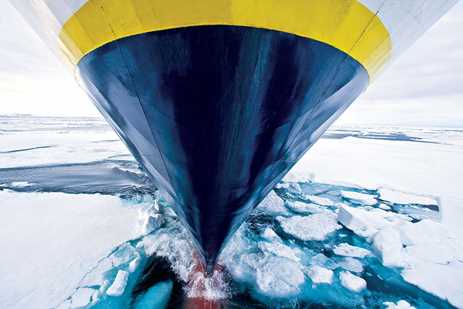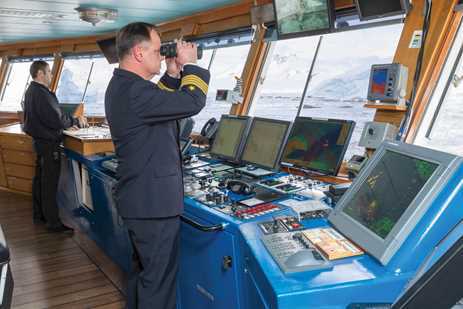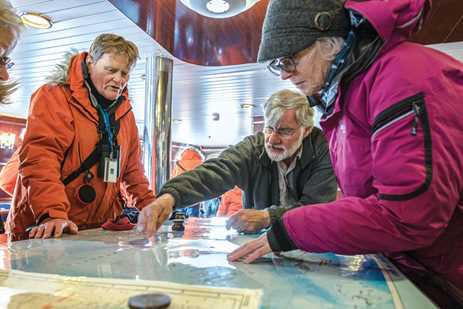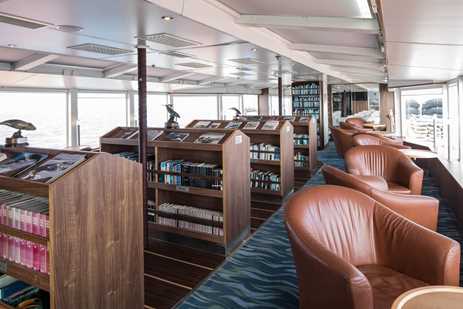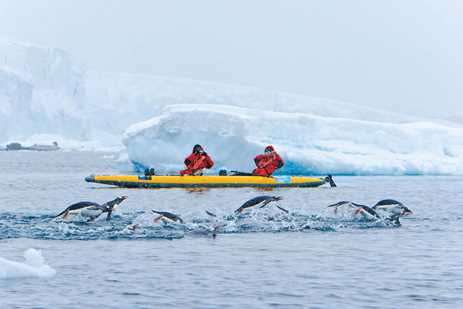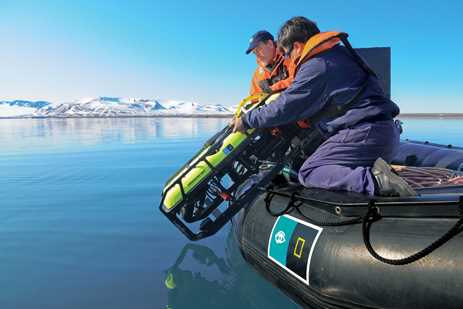Learn more about the National Geographic Explorer and join her aboard in Antarctica or the Arctic.
Call +1.212.765.7740

The embodiment of the Lindblad Expeditions-National Geographic alliance, National Geographic Explorer’s design is the result of almost 200 years of collective expedition experience. This authentic vessel truly lives up to her name—she is devoted to exploration and has traveled from pole to pole in search of thrilling discoveries. Every detail—from the welcoming chart room, right down to the art on the walls—reveals a dedication to curiosity and wonder. Ahead, find out why so many of our guests and our staff have a soft spot for this tried-and-true expedition ship. Get Inspired by Photos, Videos, Webinars, Stories, and Exclusive Offers. Sign Up
You know how at a party everyone somehow ends up in the kitchen? On an expedition aboard National Geographic Explorer, you’ll likely find people congregating on the Bridge—especially when there's an exciting wildlife sighting. Our open-door policy is one of the most unique features. You’re always welcome to come talk to the Captain and officers and learn the ins and outs of navigation. The expansive view over the bow is captivating. Grab a pair of binoculars and help the naturalists scan the sea for whales. Take your coffee up to watch the sunrise or take in the hushed darkness of the Bridge at night.
There’s nothing quite as exhilarating as standing on the bow of the National Geographic Explorer. With its low profile you have an incredible vantage point of the sea ice, icebergs, and fjords. Alex B. a guest aboard in Antarctica describes one of his favorite moments: “We were cruising through the LeMaire Channel and I was all the way out at the tip of the bow. It felt like you were practically on the glassy water, like you were thoroughly immersed in nature and this epic landscape.”
Just below the Bridge, the chart room beckons with more great views and round-the-clock cookies, coffee, and cocoa. It’s facing forward so you have direct access to the bow. Linger outside taking in the surroundings, then easily pop back inside to warm up for a spell. Watch from the windows or peruse the fascinating maps—the Captain and crew chart our voyage here so you can see where we’ve been and where we’re headed next.
Perched high at the top of the ship, the sun-drenched observation lounge is prime real estate for curious explorers. Thanks to panoramic windows that line the entire space, you’ll feel like you’re almost floating above the ship while the spectacular scenery dramatically unfolds outside. With a well-stocked library at arm’s reach, you can read up on everything from Shackleton’s historic expedition to the migratory patterns of humpback whales. And if you can’t tear yourself away from the views, most days a light lunch is served up here. Refuel for your next activity while keeping an eye on the wild.
National Geographic Explorer is equipped with a roster of tools that get you off the ship and into the heart of the wild. A fleet of double kayaks (we pioneered kayaking in polar geographies!) plus Zodiac landing craft allow you to get down to water-level for unprecedented experiences in the ice. Paddle among towering icebergs, cruise past penguins, or get a front-row seat to a leopard seal on the hunt. On early season Antarctica voyages, you can even strap on a pair of snowshoes or cross-country skis and blaze a trail across a frozen sea.
Above the water, the polar regions are a monochromatic swirl of black, white, and blue. So, you may be surprised by the burst of colors found beneath the ice. Our undersea specialist dives below and then shares stunning video of dazzling alien-like creatures. Unlike most of our ships, National Geographic Explorer is even equipped with a Remotely Operated Vehicle (ROV) which can descend deeper than any diver into areas never seen before. This is genuine exploration, and if you’re lucky, you might even be aboard when our team discovers species new to science.
Learn more about the National Geographic Explorer and join her aboard in Antarctica or the Arctic.
